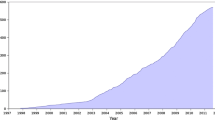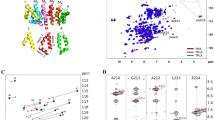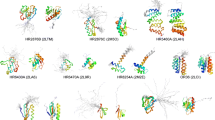Abstract
We present a novel structure determination approach that exploits the global orientational restraints from RDCs to resolve ambiguous NOE assignments. Unlike traditional approaches that bootstrap the initial fold from ambiguous NOE assignments, we start by using RDCs to compute accurate secondary structure element (SSE) backbones at the beginning of structure calculation. Our structure determination package, called rdc-Panda (RDC-based SSE PAcking with NOEs for Structure Determination and NOE Assignment), consists of three modules: (1) rdc-exact; (2) Packer; and (3) hana (HAusdorff-based NOE Assignment). rdc-exact computes the global optimal solution of backbone dihedral angles for each secondary structure element by exactly solving a system of quartic RDC equations derived by Wang and Donald (Proceedings of the IEEE computational systems bioinformatics conference (CSB), Stanford, CA, 2004a; J Biomol NMR 29(3):223–242, 2004b), and systematically searching over the roots, each of which is a backbone dihedral ϕ- or ψ-angle consistent with the RDC data. Using a small number of unambiguous inter-SSE NOEs extracted using only chemical shift information, Packer performs a systematic search for the core structure, including all SSE backbone conformations. hana uses a Hausdorff-based scoring function to measure the similarity between the experimental spectra and the back-computed NOE pattern for each side-chain from a statistically-diverse rotamer library, and drives the selection of optimal position-specific rotamers for filtering ambiguous NOE assignments. Finally, a local minimization approach is used to compute the loops and refine side-chain conformations by fixing the core structure as a rigid body while allowing movement of loops and side-chains. rdc-Panda was applied to NMR data for the FF Domain 2 of human transcription elongation factor CA150 (RNA polymerase II C-terminal domain interacting protein), human ubiquitin, the ubiquitin-binding zinc finger domain of the human Y-family DNA polymerase Eta (pol η UBZ), and the human Set2-Rpb1 interacting domain (hSRI). These results demonstrated the efficiency and accuracy of our algorithm, and show that rdc-Panda can be successfully applied for high-resolution protein structure determination using only a limited set of NMR data by first computing RDC-defined backbones.






Similar content being viewed by others
Abbreviations
- NMR:
-
Nuclear magnetic resonance
- ppm:
-
Parts per million
- RMSD:
-
Root mean square deviation
- HSQC:
-
Heteronuclear single quantum coherence spectroscopy
- NOE:
-
Nuclear Overhauser effect
- NOESY:
-
Nuclear Overhauser and exchange spectroscopy
- RDC:
-
Residual dipolar coupling
- PDB:
-
Protein Data Bank
- pol η UBZ:
-
Ubiquitin-binding zinc finger domain of the human Y-family DNA polymerase Eta
- CH:
-
Cα-Hα
- hSRI:
-
Human Set2-Rpb1 interacting domain
- FF2:
-
FF Domain 2 of human transcription elongation factor CA150 (RNA polymerase II C-terminal domain interacting protein)
- POF:
-
Principal order frame
- SA:
-
Simulated annealing
- MD:
-
Molecular dynamics
- SSE:
-
Secondary structure element
- C′:
-
Carbonyl carbon
- WPS:
-
Well-packed satisfying
- vdW:
-
van der Waals
- SM:
-
Supplementary Material
References
Andrec M, Du P, Levy RM (2004) Protein backbone structure determination using only residual dipolar couplings from one ordering medium. J Biomol NMR 21:335–347
Bailey-Kellogg C, Widge A, Kelley JJ, Berardi MJ, Bushweller JH, Donald BR (2000) The NOESY Jigsaw: automated protein secondary structure and main-chain assignment from sparse, unassigned NMR data. J Comput Biol 7(3–4):537–558
Ball G, Meenan N, Bromek K, Smith BO, Bella J, Uhrín D (2006) Measurement of one-bond 13Cα-1Hα residual dipolar coupling constants in proteins by selective manipulation of Cα Hα spins. J Magn Reson 180:127–136
Bartels C, Xia T, Billeter M, Güntert P, Wüthrich K (1995) The program XEASY for computer-supported NMR spectral analysis of biological macromolecules. J Biomol NMR 6:1–10
Bomar MG, Pai M, Tzeng S, Li S, Zhou P (2007) Structure of the ubiquitin-binding zinc finger domain of human DNA Y-polymerase η. EMBO Rep 8:247–251
Brünger AT (1992) X-PLOR, Version 3.1: a system for X-ray crystallography and NMR. J Am Chem Soc
Chen CC, Singh JP, Altman RB (1998) The hierarchical organization of molecular structure computations. J Comput Biol 5:409–422
Coggins BE, Zhou P (2003) PACES: protein sequential assignment by computer-assisted exhaustive search. J Biomol NMR 26:93–111
Coggins BE, Zhou P (2008) High resolution 4-D spectroscopy with sparse concentric shell sampling and FFT-CLEAN. J Biomol NMR 42: 225–239
Cornilescu G, Marquardt JL, Ottiger M, Bax A (1998) Validation of protein structure from anisotropic carbonyl chemical shifts in a dilute liquid crystalline phase. J Am Chem Soc 120:6836–6837
Cornilescu G, Delaglio F, Bax A (1999) Protein backbone angle restraints from searching a database for chemical shift and sequence homology. J Biomol NMR 13:289–302
Davis IW, Murray LW, Richardson JS, Richardson DC (2004) MolProbity: structure validation and all-atom contact analysis for nucleic acids and their complexes. Nucleic Acids Res 32:W615–W619
Delaglio F, Grzesiek S, Vuister GW, Zhu G, Pfeifer J, Bax A (1995) NMRPipe: a multidimensional spectral processing system based on UNIX pipes. J Biomol NMR 6:277–293
Delaglio F, Kontaxis G, Bax A (2000) Protein structure determination using molecular fragment replacement and NMR dipolar couplings. J Am Chem Soc 122:2142–2143
Donald BR, Martin J (2009) Automated NMR assignment and protein structure determination using sparse dipolar coupling constraints. Prog NMR Spectrosc 55(2):101–127
Fiorito F, Herrmann T, Damberger F, Wüthrich K (2008) Automated amino acid side-chain NMR assignment of proteins using (13)C- and (15)N-resolved 3D [(1)H, (1)H]-NOESY. J Biomol NMR 42:23–33
Fowler CA, Tian F, Al-Hashimi HM, Prestegard JH (2000) Rapid determination of protein folds using residual dipolar couplings. J Mol Biol 304:447–460
Georgiev I, Lilien RH, Donald BR (2008) The minimized dead-end elimination criterion and its application to protein redesign in a hybrid scoring and search algorithm for computing partition functions over molecular ensembles. J Comput Chem 29:1527–1542
Gronwald W, Moussa S, Elsner R, Jung A, Ganslmeier B, Trenner J, Kremer W, Neidig K-P, Kalbitzer HR (2002) Automated assignment of NOESY NMR spectra using a knowledge based method (KNOWNOE). J Biomol NMR 23:271–287
Güntert P (2003) Automated NMR protein structure determination. Prog Nucl Magn Reson Spectrosc 43:105–125
Han J, Kamber M (2006) Data mining: concepts and techniques. Morgan Kaufmann Publishers, San Francisco
Hayes-Roth B, Buchanan B, Lichtarge O, Hewtt M, Altman R, Brinkley J, Cornelius C, Duncan B, Jardetzky O (1986) PROTEAN: deriving protein structure from constraints. In: Proceedings of the fifth national conference on artificial intelligence, pp 904–908
Herrmann T, Güntert P, Wüthrich K (2002) Protein NMR structure determination with automated NOE assignment using the new software CANDID and the torsion angle dynamics algorithm DYANA. J Mol Biol 319(1):209–227
Huang YJ, Tejero R, Powers R, Montelione GT (2006) A topology-constrained distance network algorithm for protein structure determination from NOESY data. Proteins Struct Funct Bioinform 62(3):587–603
Hus JC, Marion D, Blackledge M (2001) Determination of protein backbone structure using only residual dipolar couplings. J Am Chem Soc 123:1541–1542
Hus JC, Salmon L, Bouvignies G, Lotze J, Blackledge M, Brüschweiler R (2008) 16-Fold Degeneracy of peptide plane orientations from residual dipolar couplings: analytical treatment and implications for protein structure determination. J Am Chem Soc 130:15927–15937
Huttenlocher DP, Jaquith EW (1995) Computing visual correspondence: incorporating the probability of a false match. In: Proceedings of the fifth international conference on computer vision (ICCV 95), pp 515–522
Huttenlocher DP, Kedem K (1992) Distance metrics for comparing shapes in the plane. In: Donald BR, Kapur D, Mundy J (eds) Symbolic and numerical computation for artificial intelligence. Academic Press, New York, pp 201–219
Johnson BA, Blevins RA (1994) NMRView: a computer program for the visualization and analysis of NMR data. J Biomol NMR 4:603–614
Kuszewski J, Schwieters CD, Garrett DS, Byrd RA, Tjandra N, Clore GM (2004) Completely automated, highly error-tolerant macromolecular structure determination from multidimensional nuclear overhauser enhancement spectra and chemical shift assignments. J Am Chem Soc 126(20):6258–6273
Langmead C, Donald B (2004) An expectation/maximization nuclear vector replacement algorithm for automated NMR resonance assignments. J Biomol NMR 29(2):111–138
Li M, Phatnani HP, Guan Z, Sage H, Greenleaf AL, Zhou P (2005) Solution structure of the Set2-Rpb1 interacting domain of human Set2 and its interaction with the hyperphosphorylated C-terminal domain of Rpb1. Proc Natl Acad Sci 102:17636–17641
Linge JP, Habeck M, Rieping W, Nilges M (2003) ARIA: automated NOE assignment and NMR structure calculation. Bioinformatics 19(2):315–316
Lovell SC, Word JM, Richardson JS, Richardson DC (2000) The penultimate rotamer library. Proteins Struct Funct Genet 40:389–408
Mumenthaler C, Güntert P, Braun W, Wüthrich K (1997) Automated combined assignment of NOESY spectra and three-dimensional protein structure determination. J Biomol NMR 10(4):351–362
Ottiger M, Delaglio F, Bax A (1998) Measurement of J and dipolar couplings from simplified two-dimensional NMR spectra. J Magn Reson 138:373–378
Permi P, Rosevear PR, Annila A (2000) A set of HNCO-based experiments for measurement of residual dipolar couplings in 15N, 13C, (2H)-labeled proteins. J Biomol NMR 17:43–54
Potluri S, Yan AK, Chou JJ, Donald BR, Bailey-Kellogg C (2006) Structure determination of symmetric homo-oligomers by a complete search of symmetry configuration space using NMR restraints and van der Waals packing. Proteins 65:203–219
Potluri S, Yan AK, Donald BR, Bailey-Kellogg C (2007) A complete algorithm to resolve ambiguity for intersubunit NOE assignment in structure determination of symmetric homo-oligomers. Protein Sci 16:69–81
Rieping W, Habeck M, Nilges M (2005) Inferential structure determination. Science 309:303–306
Ruan K, Briggman KB, Tolman JR (2008) De novo determination of internuclear vector orientations from residual dipolar couplings measured in three independent alignment media. J Biomol NMR 41:61–76
Skrynnikov NR, Kay LE (2000) Assessment of molecular structure using frame-independent orientational restraints derived from residual dipolar couplings. J Biomol NMR 18(3):239–252
Tian F, Valafar H, Prestegard JH. (2001) A dipolar coupling based strategy for simultaneous resonance assignment and structure determination of protein backbones. J Am Chem Soc 123:11791–11796
Tjandra N, Bax A (1997) Direct measurement of distances and angles in biomolecules by NMR in a dilute liquid crystalline medium. Science 278:1111–1114
Tolman JR, Flanagan JM, Kennedy MA, Prestegard JH (1995) Nuclear magnetic dipole interactions in field-oriented proteins: Information for structure determination in solution. Proc Natl Acad Sci USA 92:9279–9283
Vijay-Kumar S, Bugg CE, Cook WJ (1987) Structure of ubiquitin refined at 1.8 A resolution. J Mol Biol 194:531–544
Vuister GW, Bax A (1993) Quantitative J correlation: a new approach for measuring homonuclear three-bond J(HNHα) coupling constants in 15N-enriched proteins. J Am Chem Soc 115:7772–7777
Wang L, Donald BR (2004a) Analysis of a systematic search-based algorithm for determining protein backbone structure from a minimal number of residual dipolar couplings. In: Proceedings of The IEEE computational systems bioinformatics conference (CSB), Stanford, CA (August 2004), pp 319–330, PMID: 16448025
Wang L, Donald BR (2004b) Exact solutions for internuclear vectors and backbone dihedral angles from NH residual dipolar couplings in two media, and their application in a systematic search algorithm for determining protein backbone structure. J Biomol NMR 29(3):223–242
Wang L, Donald BR (2005) An efficient and accurate algorithm for assigning nuclear overhauser effect restraints using a rotamer library ensemble and residual dipolar couplings. In: The IEEE computational systems bioinformatics conference (CSB), Stanford, CA (August 2005), pp 189–202, PMID: 16447976
Wang L, Mettu R, Donald BR (2006) A polynomial-time algorithm for de novo protein backbone structure determination from NMR data. J Comput Biol 13(7):1276–1288
Wedemeyer WJ, Rohl CA, Scheraga HA (2002) Exact solutions for chemical bond orientations from residual dipolar couplings. J Biomol NMR 22:137–151
Zeng J, Tripathy C, Zhou P, Donald BR (2008) A Hausdorff-based NOE assignment algorithm using protein backbone determined from residual dipolar couplings and rotamer patterns. In: Proceedings of the 7th annual international conference on computational systems bioinformatics, Stanford CA, pp 169–181. ISBN 1752–7791. PMID: 19122773
Acknowledgements
We thank Dr. A. Yershova, Mr. J. Martin, Prof. J. Richardson, Prof. D. Richardson, Dr. S. Apaydin and all members of the Donald and Zhou Labs for helpful discussions and comments. We are grateful to Ms. M. Bomar for helping us with pol η UBZ NMR data. We thank Mr. D. Keedy, Prof. J. Richardson, Prof. D. Richardson and other members in the Richardson lab for helpful comments on our computed FF2 structures. This work is supported by the following Grants from National Institutes of Health: R01 GM-65982 to B. R. Donald and R01 GM-079376 to P. Zhou.
Author information
Authors and Affiliations
Corresponding authors
Additional information
The methodology developed in this paper has been applied to compute the ensemble of structures for FF2. The atomic coordinates have been deposited into the Protein Data Bank (PDB ID: 2KIQ).
Electronic supplementary material
Below is the link to the electronic supplementary material.
Rights and permissions
About this article
Cite this article
Zeng, J., Boyles, J., Tripathy, C. et al. High-resolution protein structure determination starting with a global fold calculated from exact solutions to the RDC equations. J Biomol NMR 45, 265–281 (2009). https://doi.org/10.1007/s10858-009-9366-3
Received:
Accepted:
Published:
Issue Date:
DOI: https://doi.org/10.1007/s10858-009-9366-3




